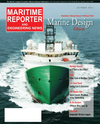
Page 57: of Maritime Reporter Magazine (October 2011)
Marine Design Annual
Read this page in Pdf, Flash or Html5 edition of October 2011 Maritime Reporter Magazine
fective period to use EQUATE. It gives owners a financial basis on which to make technology decisions at the begin- ning of the vessel?s life. We build the model based on design data and what theship is intended to do. We can tell a client, if you use a higher efficiency motor, here?s the maximum savings that you can attain in one year, based on the anticipated operational profile and antic- ipated load consumption.Do you have any commercial marine case studies with the system? Gaffney: We did an on board energy audit for Skaugen Petro Trans, Inc. (SPT) on a class of tankers and on one supply vessel. The supply boat was going to be repowered and SPT needed to understand where its current energy consumption was, both on the main engines and the auxiliaries. We went on board and meas- ured all the auxiliary loads and came upwith a set of ECMs that would allow the vessel to go from a 100Kw auxiliary en- gine down to a 40Kw auxiliary engine. On the main engine side, we attachedtemporary torque meters to the shaft anddid T-trials to get a true understanding of the real power requirements. We found that they could use a smaller main engine as well. So the owner had a much smaller capital outlay for the repower and can now realize big savings on his annual en- ergy bill at sea and in port. On the tanker we took the same meas- urements on board and determined themost cost effective speed at which to transit, when possible. The auxiliary side of the tanker included a steam system used for unloading cargo for their large cargo pumps. We discovered that if they optimized the boiler and pump load while discharging and only operated at certain discharge rates, they could save about $55,000 year or so ? just from that one ECM. And the energy savings discovered for this one tanker were applicable to the entire class of SPT tankers. Can you give a ballpark figure as to how much it costs for your energy and emis- sion assessment using EQUATE, and some insights on the projected time frame for Return on Investment? Wolff : It depends on the size of the shipand how much equipment is on board. An energy assessment with baseline and ECM report could range between$50,000 for a small vessel with few sys- tems, to $500,000 for a large, complex vessel, such as a Navy ship. A complex, commercial ship, like a tanker, could run about $75,000. We have never done an assessment that did not have the potential to pay for itself in the first year. This in- cludes the cost of implementing the en-ergy management plan and making upgrades to equipment. Owners that have a number of vessels in the same class can use one assessment on a single vessel and apply it to the entire class.Gaffney: There?s always a way to imple- ment an energy management plan through a self-funding program. Opera- tional changes often pay for the cost ofthe assessment and then some. The fol- lowing year the company can put the an- nual cost savings into investing on equipment upgrades which will bringeven greater savings, and so on. October 2011www.marinelink.com 57A screen shot of a data entry window for Alaris Companies? in-house EQUATE energy modeling software tool. Michael Gaffney, EVP of Engineering The Alaris engineers who performed an energy assessment aboard the U.S. Coast Guard Cutter Waesche in Alameda, Calif., from left to right: Michael Gaffney, Tom Goodridge, Chris Bobinger and Randall Frisk. MR Oct.11 # 7 (50-56):MR Template 10/5/2011 3:31 PM Page 57

 56
56

 58
58
